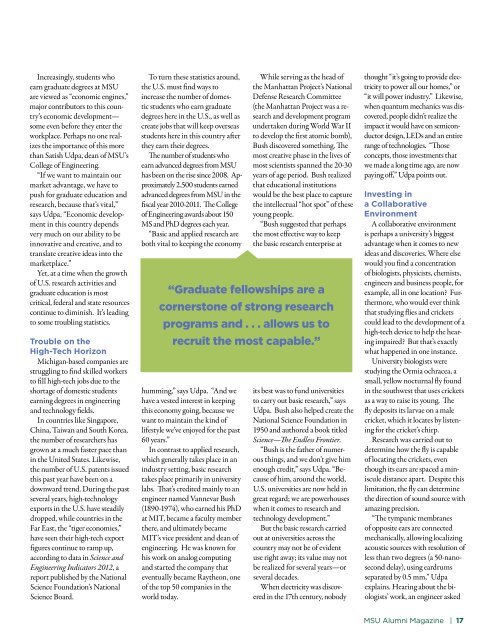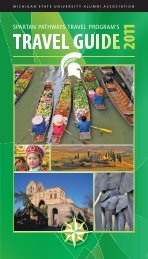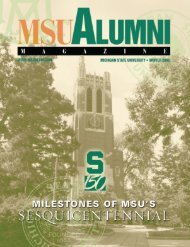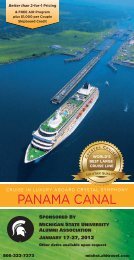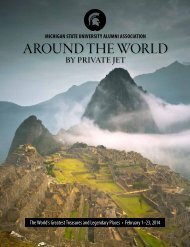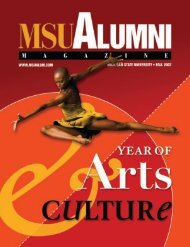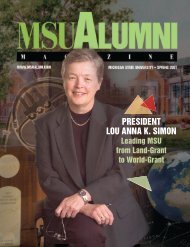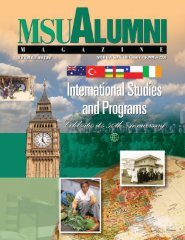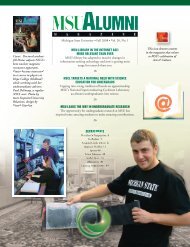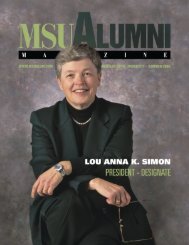Raving fans wear Spartan jewelry - MSU Alumni Association ...
Raving fans wear Spartan jewelry - MSU Alumni Association ...
Raving fans wear Spartan jewelry - MSU Alumni Association ...
Create successful ePaper yourself
Turn your PDF publications into a flip-book with our unique Google optimized e-Paper software.
Increasingly, students who<br />
earn graduate degrees at <strong>MSU</strong><br />
are viewed as “economic engines,”<br />
major contributors to this country’s<br />
economic development—<br />
some even before they enter the<br />
workplace. Perhaps no one realizes<br />
the importance of this more<br />
than Satish Udpa, dean of <strong>MSU</strong>’s<br />
College of Engineering.<br />
“If we want to maintain our<br />
market advantage, we have to<br />
push for graduate education and<br />
research, because that’s vital,”<br />
says Udpa. “Economic development<br />
in this country depends<br />
very much on our ability to be<br />
innovative and creative, and to<br />
translate creative ideas into the<br />
marketplace.”<br />
Yet, at a time when the growth<br />
of U.S. research activities and<br />
graduate education is most<br />
critical, federal and state resources<br />
continue to diminish. It’s leading<br />
to some troubling statistics.<br />
Trouble on the<br />
High-Tech Horizon<br />
Michigan-based companies are<br />
struggling to find skilled workers<br />
to fill high-tech jobs due to the<br />
shortage of domestic students<br />
earning degrees in engineering<br />
and technology fields.<br />
In countries like Singapore,<br />
China, Taiwan and South Korea,<br />
the number of researchers has<br />
grown at a much faster pace than<br />
in the United States. Likewise,<br />
the number of U.S. patents issued<br />
this past year have been on a<br />
downward trend. During the past<br />
several years, high-technology<br />
exports in the U.S. have steadily<br />
dropped, while countries in the<br />
Far East, the “tiger economies,”<br />
have seen their high-tech export<br />
figures continue to ramp up,<br />
according to data in Science and<br />
Engineering Indicators 2012, a<br />
report published by the National<br />
Science Foundation’s National<br />
Science Board.<br />
To turn these statistics around,<br />
the U.S. must find ways to<br />
increase the number of domestic<br />
students who earn graduate<br />
degrees here in the U.S., as well as<br />
create jobs that will keep overseas<br />
students here in this country after<br />
they earn their degrees.<br />
The number of students who<br />
earn advanced degrees from <strong>MSU</strong><br />
has been on the rise since 2008. Approximately<br />
2,500 students earned<br />
advanced degrees from <strong>MSU</strong> in the<br />
fiscal year 2010-2011. The College<br />
of Engineering awards about 150<br />
MS and PhD degrees each year.<br />
“Basic and applied research are<br />
both vital to keeping the economy<br />
humming,” says Udpa. “And we<br />
have a vested interest in keeping<br />
this economy going, because we<br />
want to maintain the kind of<br />
lifestyle we’ve enjoyed for the past<br />
60 years.”<br />
In contrast to applied research,<br />
which generally takes place in an<br />
industry setting, basic research<br />
takes place primarily in university<br />
labs. That’s credited mainly to an<br />
engineer named Vannevar Bush<br />
(1890-1974), who earned his PhD<br />
at MIT, became a faculty member<br />
there, and ultimately became<br />
MIT’s vice president and dean of<br />
engineering. He was known for<br />
his work on analog computing<br />
and started the company that<br />
eventually became Raytheon, one<br />
of the top 50 companies in the<br />
world today.<br />
While serving as the head of<br />
the Manhattan Project’s National<br />
Defense Research Committee<br />
(the Manhattan Project was a research<br />
and development program<br />
undertaken during World War II<br />
to develop the first atomic bomb),<br />
Bush discovered something. The<br />
most creative phase in the lives of<br />
most scientists spanned the 20-30<br />
years of age period. Bush realized<br />
that educational institutions<br />
would be the best place to capture<br />
the intellectual “hot spot” of these<br />
young people.<br />
“Bush suggested that perhaps<br />
the most effective way to keep<br />
the basic research enterprise at<br />
“Graduate fellowships are a<br />
cornerstone of strong research<br />
programs and . . . allows us to<br />
recruit the most capable.”<br />
its best was to fund universities<br />
to carry out basic research,” says<br />
Udpa. Bush also helped create the<br />
National Science Foundation in<br />
1950 and authored a book titled<br />
Science—The Endless Frontier.<br />
“Bush is the father of numerous<br />
things, and we don’t give him<br />
enough credit,” says Udpa. “Because<br />
of him, around the world,<br />
U.S. universities are now held in<br />
great regard; we are powerhouses<br />
when it comes to research and<br />
technology development.”<br />
But the basic research carried<br />
out at universities across the<br />
country may not be of evident<br />
use right away; its value may not<br />
be realized for several years—or<br />
several decades.<br />
When electricity was discovered<br />
in the 17th century, nobody<br />
thought “it’s going to provide electricity<br />
to power all our homes,” or<br />
“it will power industry.” Likewise,<br />
when quantum mechanics was discovered,<br />
people didn’t realize the<br />
impact it would have on semiconductor<br />
design, LEDs and an entire<br />
range of technologies. “Those<br />
concepts, those investments that<br />
we made a long time ago, are now<br />
paying off,” Udpa points out.<br />
Investing in<br />
a Collaborative<br />
Environment<br />
A collaborative environment<br />
is perhaps a university’s biggest<br />
advantage when it comes to new<br />
ideas and discoveries. Where else<br />
would you find a concentration<br />
of biologists, physicists, chemists,<br />
engineers and business people, for<br />
example, all in one location Furthermore,<br />
who would ever think<br />
that studying flies and crickets<br />
could lead to the development of a<br />
high-tech device to help the hearing<br />
impaired But that’s exactly<br />
what happened in one instance.<br />
University biologists were<br />
studying the Ormia ochracea, a<br />
small, yellow nocturnal fly found<br />
in the southwest that uses crickets<br />
as a way to raise its young. The<br />
fly deposits its larvae on a male<br />
cricket, which it locates by listening<br />
for the cricket’s chirp.<br />
Research was carried out to<br />
determine how the fly is capable<br />
of locating the crickets, even<br />
though its ears are spaced a miniscule<br />
distance apart. Despite this<br />
limitation, the fly can determine<br />
the direction of sound source with<br />
amazing precision.<br />
“The tympanic membranes<br />
of opposite ears are connected<br />
mechanically, allowing localizing<br />
acoustic sources with resolution of<br />
less than two degrees (a 50-nanosecond<br />
delay), using eardrums<br />
separated by 0.5 mm,” Udpa<br />
explains. Hearing about the biologists’<br />
work, an engineer asked<br />
<strong>MSU</strong> <strong>Alumni</strong> Magazine | 17


